ikfoundation.org
The IK Foundation
Promoting Natural & Cultural History
Since 1988


THE LATER NORDIC IRON & VIKING AGE
– Textile Traditions
This third historical essay on the textile trade and material culture of the Malmö area will look closer at the development through the later part of the Iron Age and the more complex novelties in luxury materials added to accessories and garments during the Viking Age – learned via local excavations and comparisons with some finds from other north European settlements and graves. Further observations from this period (600-1050AD) will include sailcloth, refined weaving methods, tablet-weaving, the study of textile fragments, improvement of tools and preferred dyeing plants.
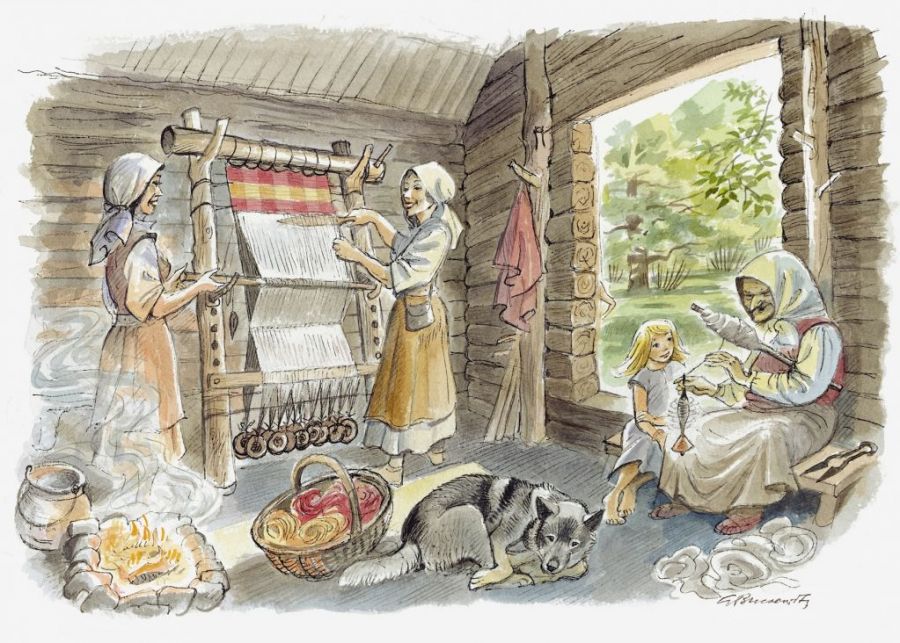 In an “opstagogn” or up-right loom like this one pictured from the Viking Age; plain, checked and striped fabrics in tabby or variations of twill could be produced. These precise skills had evolved through traditions from mother to daughter – to understand the advantages of certain raw materials, dyeing possibilities, weaving techniques and the cloths uses – which must all have been based on a good knowledge of Nature. Branches of study that we today separate into material culture, textile history, design, botany, chemistry etc. Artistic impression in water-colour by Gunnar Brusewitz in 2000.
In an “opstagogn” or up-right loom like this one pictured from the Viking Age; plain, checked and striped fabrics in tabby or variations of twill could be produced. These precise skills had evolved through traditions from mother to daughter – to understand the advantages of certain raw materials, dyeing possibilities, weaving techniques and the cloths uses – which must all have been based on a good knowledge of Nature. Branches of study that we today separate into material culture, textile history, design, botany, chemistry etc. Artistic impression in water-colour by Gunnar Brusewitz in 2000.The increasing population separated into distinct groups of the society during the later Iron Age is believed to have raised conflicts. Archaeological traces of defence structures like palisades and large amounts of weapon-related finds strengthen this view, and extending one’s territory seems to have culminated in the Vikings’ trade and conquering expeditions at the end of the Nordic Iron Age. As a consequence of these far-reaching journeys – durable sails also became necessary. This new category of textiles can be studied on the picture stones from Gotland, which depict the interlaced design of the ships’ sails. Without a doubt, large amounts of fabric were needed for these types of sails, which the Roskilde Centre for Maritime Archaeology in Denmark researched in the 1990s. Their calculations came to the conclusion that a longboat with thirty oar pairs would have needed approximately 120 square metres of sails. There is no direct proof that woollen sails of this type – or similar for smaller boats – were produced in the Malmö area, but it is likely with its close location to Öresund. One must also take into account that the tools for weaving sails were the same as for other fabrics, so concentrated finds of loom weights from the Viking Age can indicate the production of clothing and textiles for the home as well as sails.
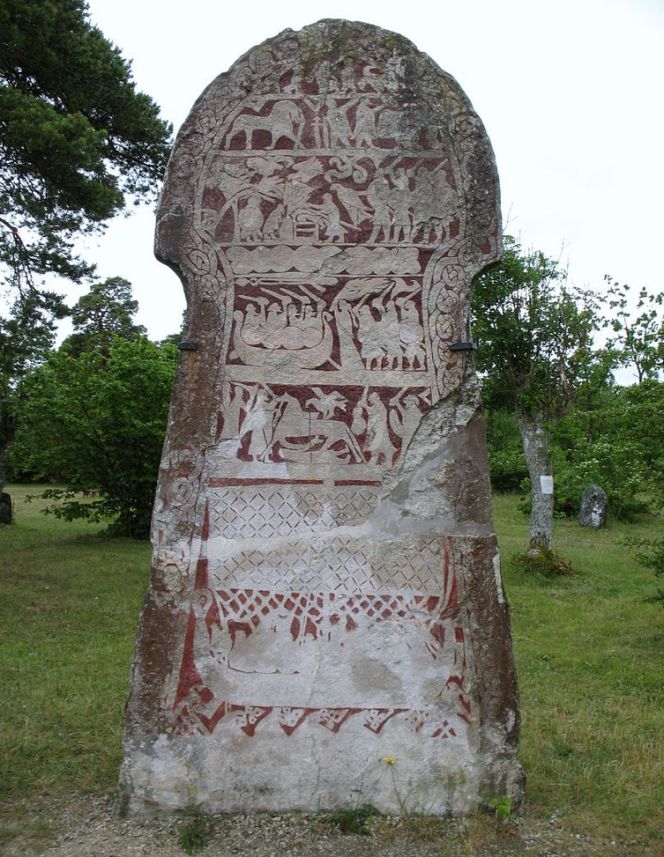 This Viking Age picture stone situated at Stora Hammar, Gotland in Sweden illustrates among many motifs the design of the large “interlaced” sails, which were part of the longships’ success and possibilities for sailing long distances. (Courtesy of Wikimedia Commons).
This Viking Age picture stone situated at Stora Hammar, Gotland in Sweden illustrates among many motifs the design of the large “interlaced” sails, which were part of the longships’ success and possibilities for sailing long distances. (Courtesy of Wikimedia Commons).Even if the actual town of Malmö was founded first during the Medieval period, the Viking Age settlements were the start of a continuous growing community lasting up until this day. In the said area, the pit houses (grophus) are one important source for information in connection to textile craft. These houses were situated close to the dwellings. Just as during the earlier part of the Iron Age, large amounts of loom weights and spindle whorls, together with several scissors and iron knives, have been excavated near the pit houses. Some such places are Svågertorp, Gessie, Södra Sallerup, Fosie and Oxie. A critical change in the production of woven fabrics in the later parts of the Iron Age was also the use of iron woollen combs, which made it possible to clean and disentangle the fibre, resulting in a much finer spun thread than before. Additionally, a weaving sword of iron was used, a tool that made it possible to weave denser cloth.
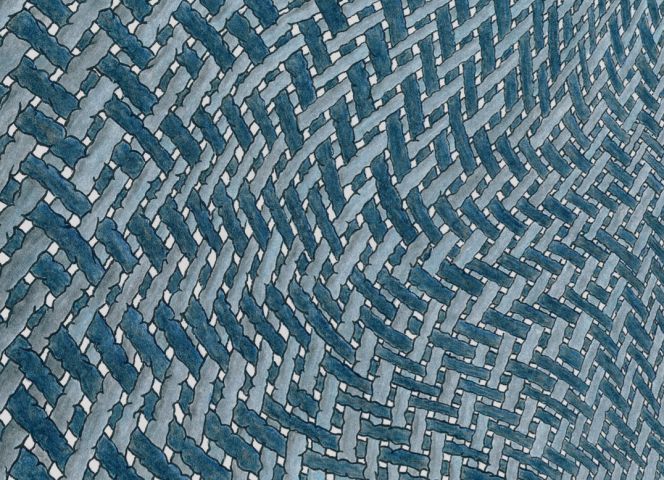 Depiction of lozenge twill, a variation of twill not found via excavations in the Malmö area but in several other Nordic locations. To get sustainable blue shades from woad (Isatis tinctoria) was by now also well-known in the Nordic area – primarily established via earlier Iron Age bog finds in Denmark. Additionally it has been proved from excavations of the Vikings’ settlements in York, that some fragmented cloths were dyed with woad. So it must be concluded that woad at this time was preferred for dyeing blue in a wider north European area. (Illustration: Helen Hodgson 2001).
Depiction of lozenge twill, a variation of twill not found via excavations in the Malmö area but in several other Nordic locations. To get sustainable blue shades from woad (Isatis tinctoria) was by now also well-known in the Nordic area – primarily established via earlier Iron Age bog finds in Denmark. Additionally it has been proved from excavations of the Vikings’ settlements in York, that some fragmented cloths were dyed with woad. So it must be concluded that woad at this time was preferred for dyeing blue in a wider north European area. (Illustration: Helen Hodgson 2001).One textile fragment has been found in the Malmö area from this period. The find only has managed to be preserved in the clayey soils in the same way as a few earlier textile remains, close to a bronze item (MHM6031). This fragment of linen was unearthed at an excavation at Lockarp. However, a scarcity of textile finds is similar in many areas – as described in the two previous articles – and due to this circumstance, archaeologists and textile researchers often need to make comparisons to well-preserved finds from Oseberg in Norway, the Danish bog finds or the town of Birka outside Stockholm when considering the rich Nordic Viking textile production and trade.
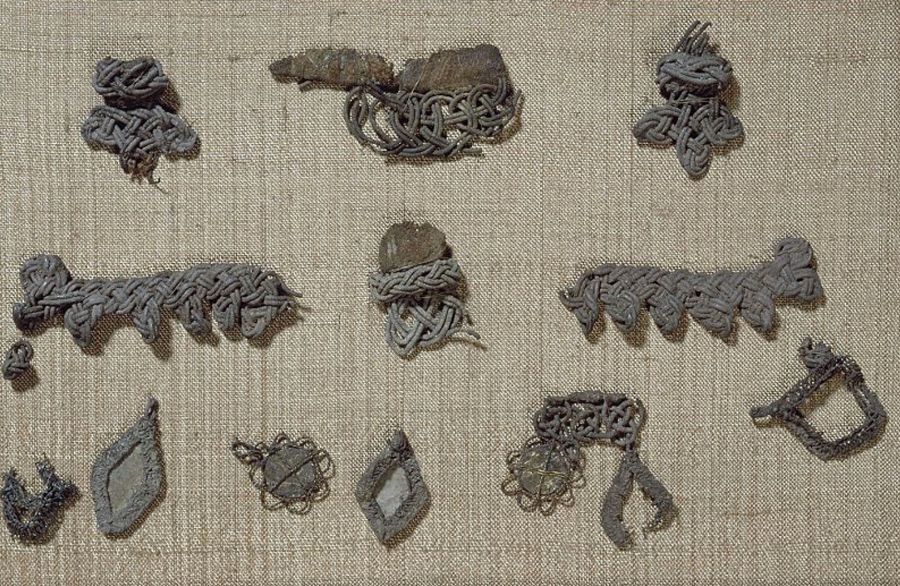 Another comparable set of textile fragments from the Viking Age, may be exemplified with finds from Björkö/Birka close to Stockholm in Sweden. These illustrated textile fragments as well as the Danish rich textile finds, also gives us some idea of that plainly woven woollen fabric or variations of twill qualities at this time in the Nordic area that were added with various complex embellishment – probably only for the wealthier in the society. (Courtesy of Historiska Museet, Stockholm, Sweden).
Another comparable set of textile fragments from the Viking Age, may be exemplified with finds from Björkö/Birka close to Stockholm in Sweden. These illustrated textile fragments as well as the Danish rich textile finds, also gives us some idea of that plainly woven woollen fabric or variations of twill qualities at this time in the Nordic area that were added with various complex embellishment – probably only for the wealthier in the society. (Courtesy of Historiska Museet, Stockholm, Sweden).Particularly in Birka, several examples of imported costly silk qualities with metallic threads of gold or silver have been excavated. Delicate worsted fabrics were also among these finds, either made locally or part of the far-reaching trade. Tablet-woven ribbons were, in some cases, added to these woollen fabrics, which made the original garments stronger and more decorative. A geographically closer located settlement with a rich Viking textile production was Löddeköpinge, c. 20 km from the Malmö area. Its textile connections as an essential coastal trading place during the Viking Age have been closely studied by the historian Eva Andersson. A substantial number of loom weights, spindle whorls, needles, etc, have been found here, and additionally, she has made comparisons from excavations in the Malmö area (Fosie and Oxie). The Oxie finds demonstrate an interesting theory due to the weighty loom weights, which implies that linen fabrics were produced. This plausible theory is strengthened by the connection to smoothing stones, tools found in the same settlement and once used to smoothen household linen. Even if linen fabric was of importance for the population, all types of woollen cloth were most probably still of even greater significance, while sheep continued to be the area's most common domesticated animal.
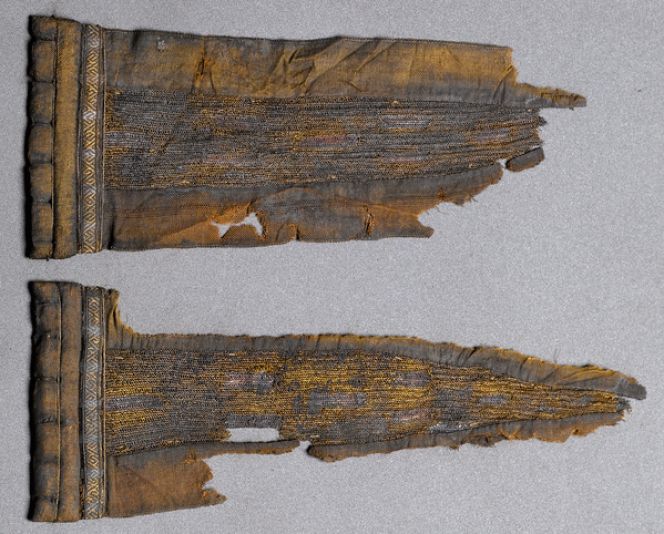 The Nordic Viking Age’s (c.790-1050AD) single tiny textile fragment from the Malmö area, is not making it possible to have a view about the precise development of the design/weaving techniques in this place. But the rich Danish finds are also for this period of great interest, demonstrating that the complexity of some fabrics now had reached higher levels. Accessories or cloth either ending up in the Nordic area via far-reaching trade or sewn from a combination of this commercially desired goods and locally woven qualities/handcraft. One such example is the “Mammen man’s costume” found in a grave in Bjerringhøj in 1868. The exclusive combination of materials is here illustrated by a detail from his mantle and explained by the National Museum as: ‘…of lilac silk material, padded with a blue woollen material, tablet-woven bands of silk, gold and silver thread and decoration in crocheting with loops in gold and silver thread…’. (Courtesy of Nationalmuseet in København, Denmark).
The Nordic Viking Age’s (c.790-1050AD) single tiny textile fragment from the Malmö area, is not making it possible to have a view about the precise development of the design/weaving techniques in this place. But the rich Danish finds are also for this period of great interest, demonstrating that the complexity of some fabrics now had reached higher levels. Accessories or cloth either ending up in the Nordic area via far-reaching trade or sewn from a combination of this commercially desired goods and locally woven qualities/handcraft. One such example is the “Mammen man’s costume” found in a grave in Bjerringhøj in 1868. The exclusive combination of materials is here illustrated by a detail from his mantle and explained by the National Museum as: ‘…of lilac silk material, padded with a blue woollen material, tablet-woven bands of silk, gold and silver thread and decoration in crocheting with loops in gold and silver thread…’. (Courtesy of Nationalmuseet in København, Denmark).From excavations in the Malmö area, large amounts of needles have been unearthed; the materials consist of bone, antlers, iron, and bronze. Additionally, needle cases made of bone are also linked to this group of finds, dating from the period of transition between the Viking Age and Medieval times. These beautifully carved items will be described in a later essay, as most of these finds are Medieval. It can be concluded that the textile-connected material is overall more substantial from the circa 450-year period of the Medieval times in Malmö than from the more extended pre-historic period.
Notice: Place names in italics are geographical areas, today within or very closely situated to the city of Malmö. For a full Bibliography and a complete list of excavated fragments, tools, etc, please see the Swedish article by Viveka Hansen, 2001.
Sources:
- Hansen, Viveka, ‘Förhistoriska och Medeltida Textilier i Malmö’, Elbogen pp. 73-144. 2001 (pp. 89-102).
- Historiska Museet, Stockholm, Sweden: Digital source (Textile fragments).
- Nationalmuseet, København, Denmark: Digital source (The Mammen man’s grave, the costume).
- Wikipedia (Search words: Stora Hammars Stones).
Essays
The iTEXTILIS is a division of The IK Workshop Society – a global and unique forum for all those interested in Natural & Cultural History from a textile Perspective.
Open Access essays, licensed under Creative Commons and freely accessible, by Textile historian Viveka Hansen, aim to integrate her current research, printed monographs, and earlier projects dating back to the late 1980s. Some essays feature rare archive material originally published in other languages, now available in English for the first time, revealing aspects of history that were previously little known outside northern European countries. Her work also explores various topics, including the textile trade, material culture, cloth manufacturing, fashion, natural dyeing, and the intriguing world of early travelling naturalists – such as the "Linnaean network" – viewed through a global historical lens.
For regular updates and to fully utilise iTEXTILIS' features, we recommend subscribing to our newsletter, iMESSENGER.
been copied to your clipboard




– a truly European organisation since 1988
Legal issues | Forget me | and much more...
You are welcome to use the information and knowledge from
The IK Workshop Society, as long as you follow a few simple rules.
LEARN MORE & I AGREE







